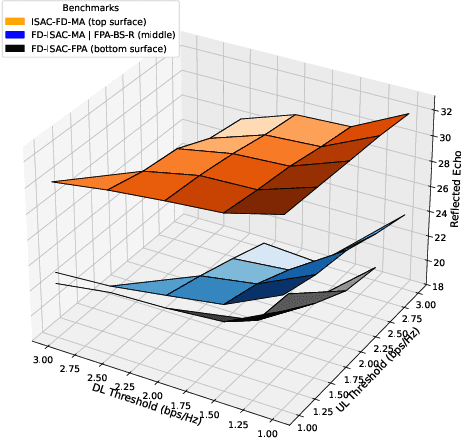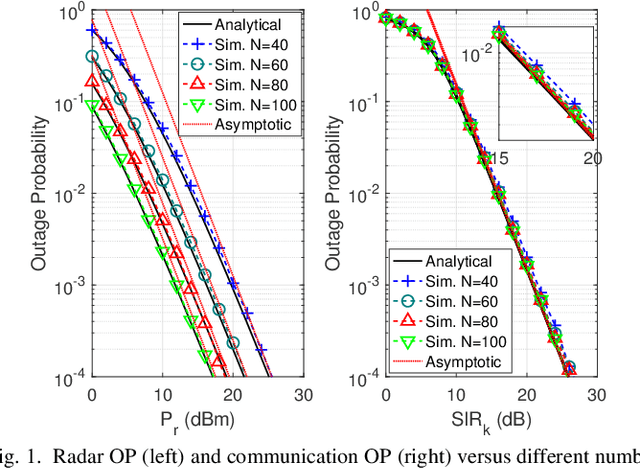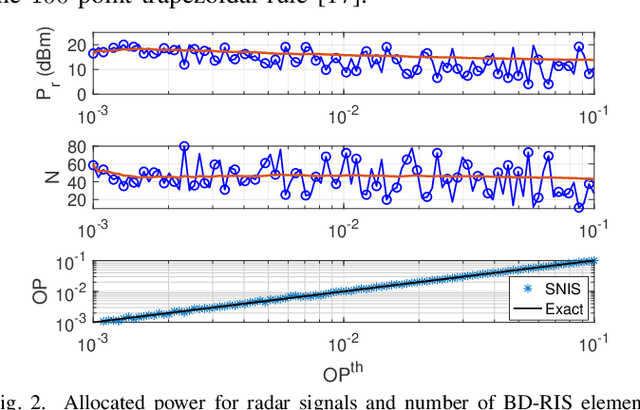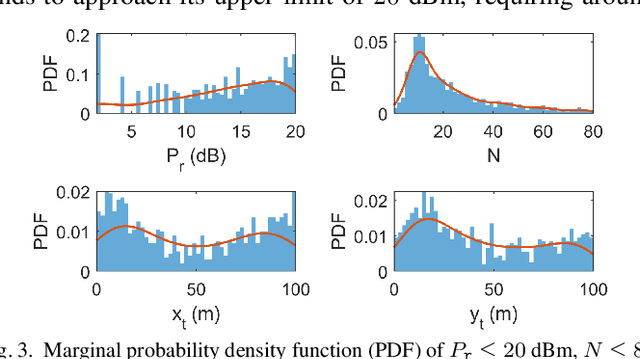Chadi Assi
Joint Power Control and Antenna Positioning for Uplink RSMA in Pinching Antenna Systems
Dec 23, 2025Abstract:This paper investigates a rate-splitting multiple access (RSMA) for uplink pinching antenna system (PASS). Our objective is to maximize the uplink sum rate by jointly optimizing a continuous antenna positioning and user's transmission power. The formulated problem is highly non-convex and difficult to solve directly; to address this challenge, we propose an alternating optimization (AO) framework which decomposes the original problem into two tractable sub-problems, namely (i) power allocation optimization sub-problem and (ii) antenna position optimization sub-problem. Both sub-problems are solved using successive convex approximation (SCA)-based algorithm and solved alternatively until convergence. The RSMA access for PASS is compared with conventional non-orthogonal multiple access (NOMA) and space-division multiple access (SDMA) techniques. The performance of discrete antenna activation with PASS strategy is also examined. Simulation results demonstrate that our proposed framework significantly enhances the achievable sum rate compared to other multiple access methods.
Joint Power Allocation and Radiation Optimization in NOMA-Assisted Pinching Antenna Systems
Nov 06, 2025Abstract:This paper explores a joint optimization of transmit power allocation and radiation coefficients in a downlink Pinching Antenna SyStem (PASS) employing Non-Orthogonal Multiple Access (NOMA). By leveraging the PASS-enabled flexible channel adjustment and NOMA's power allocation adaptability, a sum rate maximization problem is formulated with the objective of simultaneously optimizing base station (BS)'s transmit power coefficients and pinching antenna (PA)'s radiation powers. Due to its non-convexity and complexity, the formulated optimization problem is challenging to solve directly. Hence, we decompose the main problem into two sub-problems, namely transmit power allocation sub-problem and PA radiation power allocation sub-problem. In the first sub-problem, closed-form solutions are derived for the BS's power allocation among NOMA users. Meanwhile, in the second sub-problem, we optimize the PA's radiation power utilizing successive convex approximation (SCA). These two sub-problems are solved alternatively using Alternating Optimization (AO) until convergence. It should be noted that decoding order plays a significant role in NOMA-assisted PASS. Hence, two variations of decoding order are considered, namely: i) a high-complexity exhaustive search approach, and, ii) a low-complexity alternative that utilizes pre-determined channel information. Numerical results show that our proposed approach substantially improves the system's sum-rate compared to widely adopted equal power allocation PASS schemes.
PUL-Inter-slice Defender: An Anomaly Detection Solution for Distributed Slice Mobility Attacks
Oct 02, 2025Abstract:Network Slices (NSs) are virtual networks operating over a shared physical infrastructure, each designed to meet specific application requirements while maintaining consistent Quality of Service (QoS). In Fifth Generation (5G) networks, User Equipment (UE) can connect to and seamlessly switch between multiple NSs to access diverse services. However, this flexibility, known as Inter-Slice Switching (ISS), introduces a potential vulnerability that can be exploited to launch Distributed Slice Mobility (DSM) attacks, a form of Distributed Denial of Service (DDoS) attack. To secure 5G networks and their NSs against DSM attacks, we present in this work, PUL-Inter-Slice Defender; an anomaly detection solution that leverages Positive Unlabeled Learning (PUL) and incorporates a combination of Long Short-Term Memory Autoencoders and K-Means clustering. PUL-Inter-Slice Defender leverages the Third Generation Partnership Project (3GPP) key performance indicators and performance measurement counters as features for its machine learning models to detect DSM attack variants while maintaining robustness in the presence of contaminated training data. When evaluated on data collected from our 5G testbed based on the open-source free5GC and UERANSIM, a UE/ Radio Access Network (RAN) simulator; PUL-Inter-Slice Defender achieved F1-scores exceeding 98.50% on training datasets with 10% to 40% attack contamination, consistently outperforming its counterpart Inter-Slice Defender and other PUL based solutions combining One-Class Support Vector Machine (OCSVM) with Random Forest and XGBoost.
Meta-Learning-Driven Resource Optimization in Full-Duplex ISAC with Movable Antennas
Oct 01, 2025


Abstract:This paper investigates a full-duplex (FD) scenario where a base station (BS) equipped with movable antennas (MAs) simultaneously provides communication services to a set of downlink (DL) and uplink (UL) users while also enabling sensing functionalities for target detection, thereby supporting integrated sensing and communication (ISAC) technology. Additionally, a receiving BS, also equipped with MAs (denoted as BS R), is responsible for capturing the reflected echo. To optimize this setup, we formulate an optimization problem aimed at maximizing the signal-to-noise and interference ratio (SINR) of the captured echo. This is achieved by jointly optimizing the transmit beamforming vectors at the FD BS, the receiving beamforming vectors at both the FD BS and BS R, the UL users' transmit power, and the MAs' positions at both BSs, all while satisfying the quality-of-service (QoS) requirements for both sensing and communication. Given the non-convex nature of the problem and the high coupling between the variables, we employ a gradient-based meta-learning (GML) approach tailored for large-scale optimization. Numerical results demonstrate the effectiveness of the proposed meta-learning approach, achieving results within 99% of the optimal solution. Furthermore, the MA-based scheme outperforms several benchmark approaches, highlighting its advantages in practical ISAC applications.
Crosstalk-Resilient Beamforming for Movable Antenna Enabled Integrated Sensing and Communication
Sep 03, 2025



Abstract:This paper investigates a movable antenna (MA) enabled integrated sensing and communication (ISAC) system under the influence of antenna crosstalk. First, it generalizes the antenna crosstalk model from the conventional fixed-position antenna (FPA) system to the MA scenario. Then, a Cramer-Rao bound (CRB) minimization problem driven by joint beamforming and antenna position design is presented. Specifically, to address this highly non-convex flexible beamforming problem, we deploy a deep reinforcement learning (DRL) approach to train a flexible beamforming agent. To ensure stability during training, a Twin Delayed Deep Deterministic Policy Gradient (TD3) algorithm is adopted to balance exploration with reward maximization for efficient and reliable learning. Numerical results demonstrate that the proposed crosstalk-resilient (CR) algorithm enhances the overall ISAC performance compared to other benchmark schemes.
Meta-Learning Driven Movable-Antenna-assisted Full-Duplex RSMA for Multi-User Communication: Performance and Optimization
Apr 04, 2025



Abstract:Full-duplex (FD) radios at base station (BS) have gained significant interest because of their ability to simultaneously transmit and receive signals on the same frequency band. However, FD communication is hindered by self-interference (SI) and intra-cell interference caused by simultaneous uplink (UL) transmissions affecting downlink (DL) reception. These interferences significantly limit the ability to fully exploit FD's potential. Recently, movable antenna (MA) technology has emerged as a groundbreaking innovation, offering an effective way to mitigate interference by adjusting the position of each MA within the transmitter or receiver region. This dynamic repositioning allows MAs to move away from high-interference zones to areas with minimal interference, thereby enhancing multiplexing gain and improving spectral efficiency (SE). In light of this, in this paper, we investigate an FD communication system by integrating it with MAs to evaluate and investigate its effectiveness in handling SI and intra-cell interference. Moreover, we utilize rate-splitting multiple access (RSMA) as our multiple access technique in both UL and DL transmission. To achieve the full potential of the system, we evaluated three different scenarios with FD-BS-RSMA with MAs where our goal is to maximize the total sum rate of the system by jointly optimizing the transmitting and receiving beamforming vectors, UL user equipment (UE) transmission power, MA positions, and common stream split ratio of RSMA while satisfying the minimum data rate requirements of all UEs, common stream constraint, power budget requirements of BS and UL UEs, and inter-MA distance. The formulated optimization problem is highly non-convex in nature, and hence, we propose a gradient-based meta-learning (GML) approach which can handle the non-convexity in a discrete manner by optimizing each variable in a different neural network.
Beamforming for Movable and Rotatable Antenna Enabled Multi-User Communications
Mar 14, 2025


Abstract:In the development of wireless communication technology, multiple-input multiple-output (MIMO) technology has emerged as a key enabler, significantly enhancing the capacity of communication systems. However, traditional MIMO systems, which rely on fixed-position antennas (FPAs) with spacing limitations, cannot fully exploit the channel variations in the continuous spatial domain, thus limiting the system's spatial multiplexing performance and diversity. To address these limitations, movable antennas (MAs) have been introduced, offering a breakthrough in signal processing and spatial multiplexing by overcoming the constraints of FPA-based systems. Furthermore, this paper extends the functionality of MAs by introducing movable rotatable antennas (MRAs), which enhance the system's ability to optimize performance in the spatial domain by adding rotational degrees of freedom. By incorporating a dynamic precoding framework based on both antenna position and rotation angle optimization, and employing the zero-forcing (ZF) precoding method, this paper proposes an efficient optimization approach aimed at improving signal quality, mitigating interference, and solving the non-linear, constrained optimization problem using the sequential quadratic programming (SQP) algorithm. This approach effectively enhances the communication system's performance.
Modeling and Optimization for Flexible Cylindrical Arrays-Enabled Wireless Communications
Mar 14, 2025Abstract:Flexible-geometry arrays have garnered much attention in wireless communications, which dynamically adjust wireless channels to improve the system performance. In this paper, we propose a novel flexible-geometry array for a $360^\circ$ coverage, named flxible cylindrical array (FCLA), comprised of multiple flexible circular arrays (FCAs). The elements in each FCA can revolve around the circle track to change their horizontal positions, and the FCAs can move along the vertical axis to change the elements' heights. Considering that horizontal revolving can change the antenna orientation, we adopt both the omni-directional and the directional antenna patterns. Based on the regularized zero-forcing (RZF) precoding scheme, we formulate a particular compressive sensing (CS) problem incorporating joint precoding and antenna position optimization, and propose two effective methods, namely FCLA-J and FCLA-A, to solve it. Specifically, the first method involves jointly optimizing the element's revolving angle, height, and precoding coefficient within a single CS framework. The second method decouples the CS problem into two subproblems by utilizing an alternative sparse optimization approach for the revolving angle and height, thereby reducing time complexity. Simulation results reveal that, when utilizing directional radiation patterns, FCLA-J and FCLA-A achieve substantial performance improvements of 43.32\% and 25.42\%, respectively, compared to uniform cylindrical arrays (UCLAs) with RZF precoding.
Enhancing CoMP-RSMA Performance with Movable Antennas: A Meta-Learning Optimization Framework
Feb 24, 2025Abstract:This study investigates a downlink rate-splitting multiple access (RSMA) scenario in which multiple base stations (BSs), employing a coordinated multi-point (CoMP) transmission scheme, serve users equipped with movable antenna (MA) technology. Unlike traditional fixed-position antennas (FPAs), which are subject to random variations in wireless channels, MAs can be strategically repositioned to locations with more favorable channel conditions, thereby achieving enhanced spatial diversity gains.To leverage these advantages and maximize the achievable sum rate, we formulate an optimization problem that jointly determines the optimal transmit beamforming vectors at the BSs, the common stream allocation for different users, and the optimal positioning of the MAs, all while ensuring compliance with quality of service (QoS) constraints. However, the formulated problem is non-convex and computationally challenging due to the strong interdependence among the optimization variables. Traditional methods for solving large-scale optimization problems typically incur prohibitively high computational complexity. To address the above challenge, we propose a gradient-based meta-learning (GML) algorithm that operates without pre-training and is well-suited for handling large-scale optimization tasks. Numerical results demonstrate the effectiveness and accuracy of the proposed approach, achieving near-optimal performance (exceeding 97% compared to the optimal solution). Moreover, the MA-enabled CoMP-RSMA model significantly outperforms conventional benchmark schemes, yielding performance gains of up to 190% over the spatial division multiple access (SDMA) scheme and 80% over the RSMA FPA-based model. Finally, the proposed approach is shown to mitigate the sum-rate limitations imposed by interference in SDMA, achieving superior performance with fewer BSs.
Beyond Diagonal RIS for ISAC Network: Statistical Analysis and Network Parameter Estimation
Feb 18, 2025


Abstract:This paper investigates the use of beyond diagonal reconfigurable intelligent surface (BD-RIS) with $N$ elements to advance integrated sensing and communication (ISAC). We address a key gap in the statistical characterizations of the radar signal-to-noise ratio (SNR) and the communication signal-to-interference-plus-noise ratio (SINR) by deriving tractable closed-form cumulative distribution functions (CDFs) for these metrics. Our approach maximizes the radar SNR by jointly configuring radar beamforming and BD-RIS phase shifts. Subsequently, zero-forcing is adopted to mitigate user interference, enhancing the communication SINR. To meet ISAC outage requirements, we propose an analytically-driven successive non-inversion sampling (SNIS) algorithm for estimating network parameters satisfying network outage constraints. Numerical results illustrate the accuracy of the derived CDFs and demonstrate the effectiveness of the proposed SNIS algorithm.
 Add to Chrome
Add to Chrome Add to Firefox
Add to Firefox Add to Edge
Add to Edge